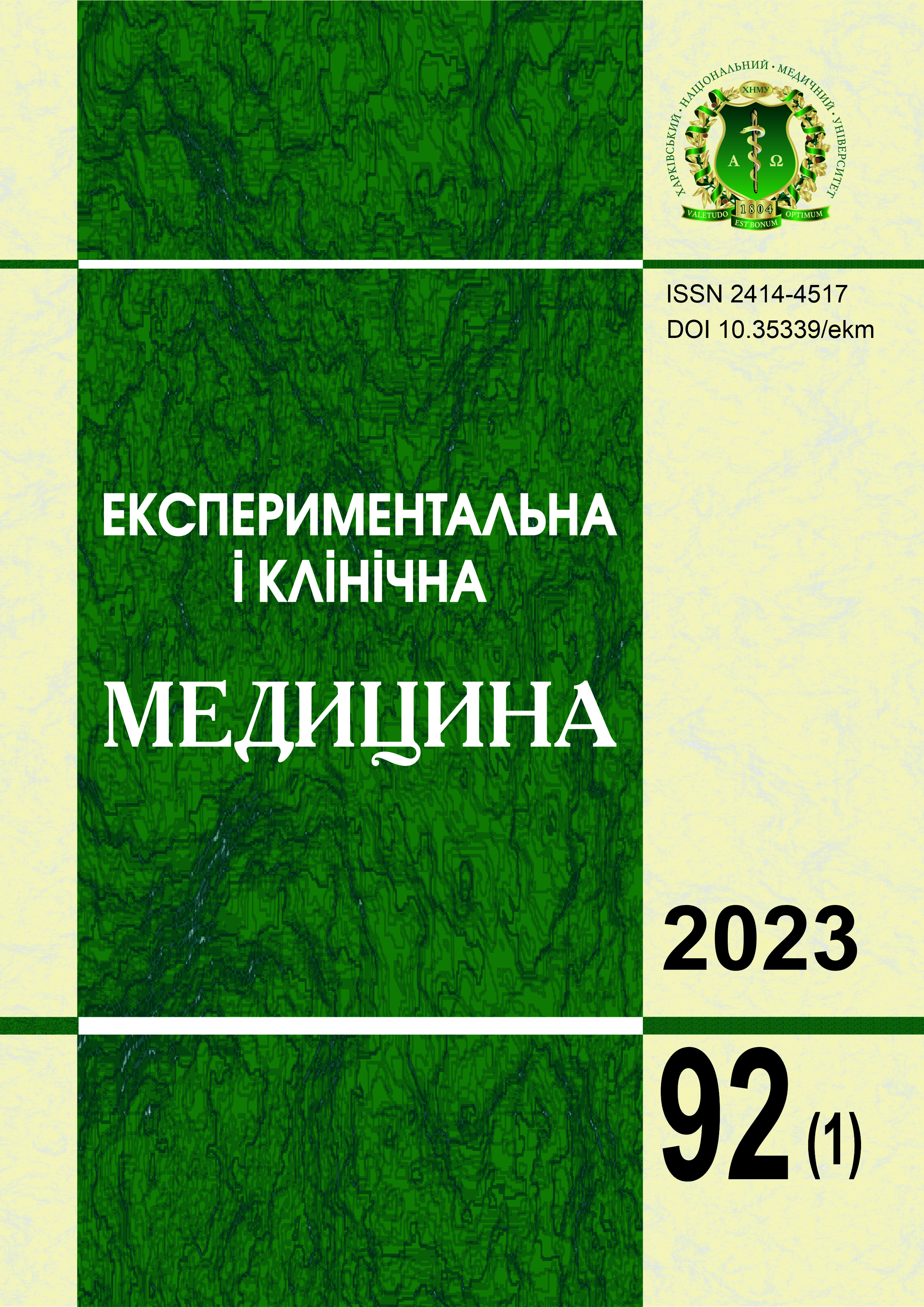Abstract
It was experimentally shown that ethanol affects the production of nitric oxide in rats. However, nitric oxide can have both a protective effect by weakening the harmful effect of ethanol on the microcirculation of the liver, and lead to liver damage by active forms of nitrogen. The purpose of the study is to study changes in the nitric oxide cycle under the conditions of modeling chronic alcohol intoxication in rats. Experiments were performed on 30 white, mature male Wistar rats, weighing 180–220 g. The animals were divided into 2 groups: I – control (n=6); II group – animals with alcoholic hepatitis (n=24) modelled by the method of forced intermittent alcoholization for 5 days, with a repeat after two days by intraperitoneal injection of a 16.5% ethanol solution in a 5% glucose solution, at the rate of 4 ml/kg of body weight. Animals were removed from the experiment on days 10, 14, 21 and 28 by taking blood from the right ventricle of the heart under thiopental anesthesia. The activity of inducible and constitutive isoforms of NO-synthase, concentration of nitrite, nitrosothiols and peroxynitrites of alkali and alkaline earth metals, the activity of nitrite reductase, nitrate reductase and arginase were determined in rat liver homogenate. Chronic alcohol intoxication modelling for 10–28 days leads to a violation of the formation and metabolism of nitric oxide with the predominant formation of its toxic metabolites, such as peroxynitrites and nitrites, which threatens the development of nitrosative stress in the liver. Chronic alcohol intoxication on the 10th–28th days of the experiment is accompanied by a sharp decrease in the activity of the arginase-dependent pathway of arginine metabolism in the liver of rats, which indicates a violation of the deamination processes in the Krebs-Handzeleit cycle.
Keywords: nitrites, NO-synthase, peroxynitrite, alcohol, liver, rats.
References
Thomes PG, Rasineni K, Saraswathi V, Kharbanda KK, Clemens DL, Sweeney SA, et al. Natural Recovery by the Liver and Other Organs after Chronic Alcohol Use. Alcohol Res. 2021;41(1):05. DOI: 10.35946/arcr.v41.1.05. PMID: 33868869.
Mathurin P, Bataller R. Trends in the management and burden of alcoholic liver disease. J Hepatol. 2015;62(1 Suppl):S38-46. DOI: 10.1016/j.jhep.2015.03.006. PMID: 25920088.
Campollo O. Alcohol and the Liver: The Return of the Prodigal Son. Ann Hepatol. 2019;18(1):6-10. DOI: 10.5604/01.3001.0012.7854. PMID: 31113611.
Mellinger JL. Epidemiology of Alcohol Use and Alcoholic Liver Disease. Clin Liver Dis (Hoboken). 2019;13(5):136-139. DOI: 10.1002/cld.806.
Bataller R, Mandrekar P. Identifying molecular targets to improve immune function in alcoholic hepatitis. Gastroenterology. 2015;148(3):498-501. DOI: 10.1053/j.gastro.2015.01.013. PMID: 25613314.
Diesen DL, Kuo PC. Nitric oxide and redox regulation in the liver: part II. Redox biology in pathologic hepatocytes and implications for intervention. J Surg Res. 2011;167(1):96-112. DOI: 10.1016/j.jss.2009.10.006. PMID: 20400112.
Oekonomaki E, Notas G, Mouzas IA, Valatas V, Skordilis P, Xidakis C, Kouroumalis EA. Binge drinking and nitric oxide metabolites in chronic liver disease. Alcohol Alcohol. 2004;39(2):106-9. DOI: 10.1093/alcalc/agh030. PMID: 14998825.
Beier JI, McClain CJ. Mechanisms and cell signaling in alcoholic liver disease. Biol Chem. 2010;391(11):1249-64. DOI: 10.1515/BC.2010.137. PMID: 20868231.
Stepanov YuM, Didenko VI, Dynnik OB, Konenko IS, Oshmianskaia NYu, Galinsky AA. Association of morphological changes in the liver parenchyma and its rigidity under the conditions of the experimental modeling of alcoholic and toxic hepatitis. Journal of the NAMSU. 2017;23(3-4):196-204.
Akimov OY, Kostenko VO. Functioning of nitric oxide cycle in gastric mucosa of rats under excessive combined intake of sodium nitrate and fluoride. Ukr Biochem J. 2016;88(6):70-5. DOI: 10.15407/ubj88.06.070. PMID: 29236285.
Gaston B, Reilly J, Drazen JM, Fackler J, Ramdev P, Arnelle D, et al. Endogenous nitrogen oxides and bronchodilator S-nitrosothiols in human airways. Proc. Natl. Acad. Sci. USA. 1993;90:10957-61.
Singh RJ, Hogg N, Joseph J, Kalyanaraman B. Mechanism of nitric oxide release from S-nitrosothiols. J Biol Chem. 1996;271(31):18596-603. DOI: 10.1074/jbc.271.31.18596. PMID: 8702510.
Bartosz G. Peroxynitrite: mediator of the toxic action of nitric oxide. Acta Biochim Pol. 1996;43(4):645-59.
Cyr AR, Huckaby LV, Shiva SS, Zuckerbraun BS. Nitric Oxide and Endothelial Dysfunction. Crit Care Clin. 2020;36(2):307-21. DOI: 10.1016/j.ccc.2019.12.009. PMID: 32172815.
Blaya D, Rubio-Tomás T, Rodrigo-Torres D, Lozano J, Coll M, Argemi J, et al. Endothelial dysfunction markers predict short-term mortality in patients with severe alcoholic hepatitis. Hepatol Int. 2021;15(4):1006-17. DOI: 10.1007/s12072-021-10165-y. PMID: 33954832.
Yang Y, Sangwung P, Kondo R, Jung Y, McConnell MJ, Jeong J, et al. Alcohol-induced Hsp90 acetylation is a novel driver of liver sinusoidal endothelial dysfunction and alcohol-related liver disease. J Hepatol. 2021;75(2):377-86. DOI: 10.1016/j.jhep.2021.02.028. PMID: 33675874.
Liu XB, Haney JR, Cantero G, Lambert JR, Otero-Garcia M, Truong B, et al. Hepatic arginase deficiency fosters dysmyelination during postnatal CNS development. JCI Insight. 2019;4(17):e130260. DOI: 10.1172/jci.insight.130260. PMID: 31484827.

This work is licensed under a Creative Commons Attribution-NonCommercial-ShareAlike 4.0 International License.

